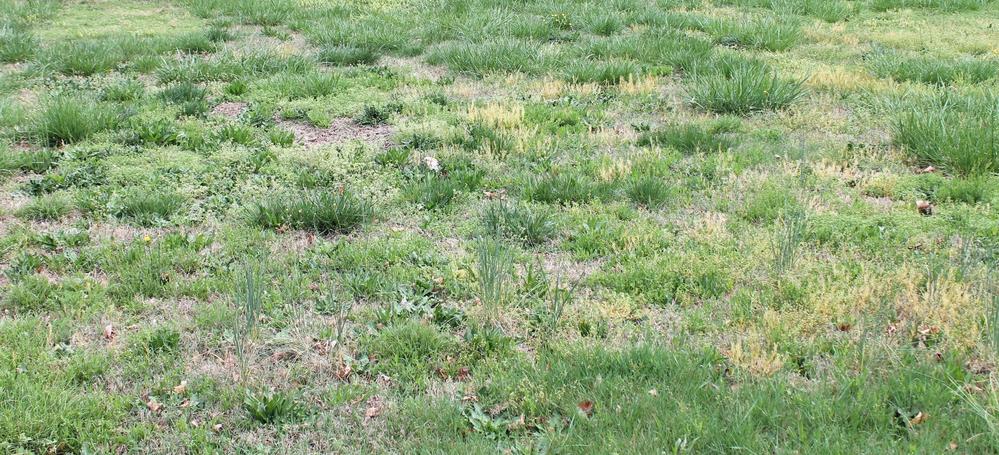As lawn care experts, we often hear the question, weed and feed or grass seed first? This decision is crucial for any lawn enthusiast aiming for a lush, healthy lawn.
If you're wondering which step to take first, you've come to the right place. In this article, we'll dive deeper into the benefits and timing of using weed and feed products versus planting grass seed.
We'll explore how each method impacts your lawn's health, the best times to apply them, and the factors you need to consider for optimal results.
So, if you're ready to transform your lawn into a vibrant, green paradise, continue reading. We know that there's a strategic way to approach this for the best possible outcome, and we're ready to guide you!
What this article covers:- Which One Should Be First?
- What Does Weed and Feed Do?
- What Does Grass Seed Do?
- When to Weed, Feed And Seed
- Different Types of Weed and Feed Products
Which One Should Be First?
From our experience, it's generally best to address weeds before seeding. If a full renovation on your lawn needs to be done, best practice is to apply a non-selective herbicide to make sure everything is removed.
Applying a weed and feed first will not tackle most weeds. Granular weed and feeds are not that effective.Liquid weed killers are much more effective making way for your new grass to grow without competition. Always read the label on the weed killer to see when it will be safe to seed.
This sequence ensures that the nutrients intended for your grass aren't diverted to the weeds. By eliminating weeds first, you create a healthier environment for the germination of grass seed.
This approach allows the new grass to establish itself without being overshadowed by existing weeds. Furthermore, using weed killer before seeding maximizes the effectiveness of both processes, leading to a lush and vibrant lawn.
Our findings show that addressing weeds first leads to a more successful lawn establishment and long-term health.

What Does Weed and Feed Do?
Weed and feed products are designed to both fertilize your lawn and control weeds. They typically contain a combination of herbicides and fertilizers.
The herbicides target and eliminate broadleaf weeds such as dandelions and clover, while the fertilizers provide essential nutrients to your grass.
Using a weed and feed helps your lawn get the nutrients it needs while eliminating weeds that can choke out new grass. However we highly suggest applying fertilizer and weed control separately.
This dual action ensures that your lawn remains healthy and vibrant. By applying weed and feed, you promote stronger grass growth and prevent weeds from competing for the same resources, leading to a lush, green lawn.
If you're looking for premium grade lawn fertilizer, look no further than Lawn Synergy. Amongst our many choices, we recommend the Almighty 20-0-10 Lawn Fertilizer and the Emerald 10-0-20 Lawn Fertilizer.
What Does Grass Seed Do?
Grass care is essential for a thriving lawn. Seeding introduces new grass to fill in bare or thin spots, promoting a fuller and healthier lawn.
The germination of grass seed requires proper soil preparation and consistent care to ensure successful growth.
This process involves loosening the soil, removing debris, and keeping the soil moist until the seeds sprout. As the new grass grows, it thickens your lawn, making it more resilient and aesthetically pleasing.
A well-seeded lawn can better withstand foot traffic, resist weed invasion, and improve the overall appearance of your outdoor space.
Overseeding is a crucial step in maintaining a vibrant and robust lawn. Overseeding your lawn is best during the fall. Summer has just finished and the heat has taken a toll on your lawn. By aerating and overseeding, new grass seed will fill in all of the thinned out areas and revving the lawn for another season.

When to Weed, Feed and Seed
Timing is everything. Early spring and early fall are the best times to apply weed and feed, followed by seeding a few weeks later.
Applying weed and feed in early spring helps tackle weeds before they become established, giving your lawn a strong start. We recommend starting with our Guardian 13-0-10 pre-emergent fertilizer early spring. Applying a pre-emergent with fertilizer will prevent weed seeds from germinating and also feed the lawn for spring. Then applying a blanket weed killer separately such as Triad select is a proven combination.
If you plan on seeding, do not apply a pre-emergent. Pre-emergent will also prevent grass seed from growing.
Early fall applications address late-season weeds and prepare your lawn for winter. This schedule allows the weed and feed enough time to take effect, creating a weed-free environment where new grass can thrive.
By waiting a few weeks after applying weed and feed, you ensure that the herbicides have neutralized and won't harm the new grass seedlings. Always check the label to see wait times.
This strategy promotes a healthy, resilient lawn that can outcompete weeds and remain lush and green throughout the year.
Different Types of Weed and Feed Products
Let's look at different weed and feed products. These products are designed to tackle weeds while nourishing your lawn, providing a convenient solution for lawn care.
They come in various formulations, each suited for specific needs and timings. Understanding the differences can help you choose the right product for your lawn.
Pre-Emergent Weed & Feed
Pre-emergent products prevent weed seeds from germinating. Use these in early spring before weeds start to grow.
By applying a weed and feed with pre-emergent herbicides, you can stop weeds before they even emerge, keeping your lawn clean and reducing the competition for your grass.
This type of product is ideal for preventing annual weeds that can be difficult to control once they have sprouted.

Post-Emergent Weed & Feed
Post-emergent products target existing weeds. They are most effective when weeds are actively growing.
This type of weed and feed is best applied during the growing season when you can see the weeds.
Post-emergent herbicides work by attacking the foliage and roots of the weeds, ensuring they are eliminated from your lawn.
This helps maintain a healthy, weed-free lawn and allows your grass to flourish without competition.
Slow-Release Weed & Feed
Slow-release formulas provide a steady supply of nutrients over time, promoting long-term lawn health.
This type of weed and feed ensures that your lawn receives consistent nutrition, reducing the need for frequent applications.
The slow-release mechanism helps prevent nutrient burn and supports sustained grass growth.
Using a slow-release product can improve the resilience and overall health of your lawn, making it better able to withstand stress and weed invasion.
Water-Soluble Weed & Feed
Water-soluble options are fast-acting and can be easily applied with a hose, offering quick results. This type of weed and feed is ideal for those who need immediate improvement in their lawn's appearance.
The water-soluble formulation ensures that the nutrients and herbicides are quickly absorbed by the grass and weeds, providing rapid action against unwanted plants.
It is a convenient and efficient way to maintain a lush, green lawn with minimal effort.
Conclusion
Transforming your lawn into a lush, green paradise starts with the right strategy.
As per our expertise, addressing weeds before seeding ensures your new grass can grow strong and healthy without competition. Following a strategic plan and choosing the right products are crucial for the best results.
At Lawn Synergy, we are committed to helping you achieve the lawn of your dreams. Our expert tips and tailored products are designed to make lawn care easy and effective. Visit our website today and take the first step towards a vibrant, weed-free lawn with Lawn Synergy.
If you want to learn more, why not check out these articles below:
- How Often to Fertilize Lawn
- How Does Grass Grow
- How Much Fertilizer for Lawn
- Will Fertilizer Kill New Grass
- How Long Does Lawn Fertilizer Take to Work
- Best Organic Fertilizer for Lawn
- Best Weed and Feed for Lawns
- Best Lawn Fertilizer for Texas
- Best Lawn Fertilizer for Florida
- Best Lawn Fertilizer for Spring
- Best Time to Fertilize Before or After Rain
- Best Lawn Fertilizer for Winter
- Best Time to Fertilize Lawn Before or After Mowing
- Liquid vs Granular Lawn Fertilizer
- Can You Put Starter Fertilizer on Existing Grass

